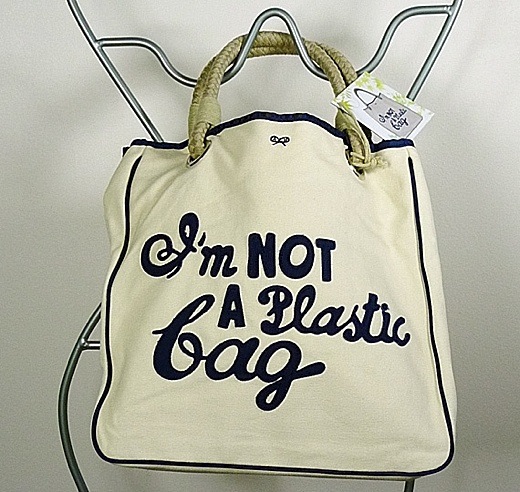 Image above: "I'm not a Plastic Bag" bag. From (http://nitrolicious.com/shop/2009/08/02/anya-hindmarch-%E2%80%9Ci%E2%80%99m-not-a-plastic-bag%E2%80%9D-tote-%E2%80%93-blue).
After completing an Environmental Impact Report (EIR), Los Angeles County Board of supervisors adopted an ordinance on November 16, 2010 banning plastic carryout bags and imposing a 10-‐cent fee on paper carryout bags.1
The EIR adopted the findings of the Ecobilan Report and the Scottish Report.2 Those reports determined that even after taking into account that paper bags hold more than plastic bags, the life cycle of a paper bag results in:
Image above: "I'm not a Plastic Bag" bag. From (http://nitrolicious.com/shop/2009/08/02/anya-hindmarch-%E2%80%9Ci%E2%80%99m-not-a-plastic-bag%E2%80%9D-tote-%E2%80%93-blue).
After completing an Environmental Impact Report (EIR), Los Angeles County Board of supervisors adopted an ordinance on November 16, 2010 banning plastic carryout bags and imposing a 10-‐cent fee on paper carryout bags.1
The EIR adopted the findings of the Ecobilan Report and the Scottish Report.2 Those reports determined that even after taking into account that paper bags hold more than plastic bags, the life cycle of a paper bag results in:
3.3 times more greenhouse gas emissions than a plastic bag. 1.1 times more nonrenewable energy than a plastic bag. 4.0 times more consumption of water than a plastic bag. 1.9 times more acid rain than a plastic bag. 1.3 times more negative air quality than a plastic bag. 14.0 times more water body eutrophication than a plastic bag. 2.7 times more solid waste production than a plastic bag. 3.3 times more greenhouse gas emissions than a plastic bagBased on the Ecobilan and Scottish Reports, the County decided to impose a 10-‐cent fee on paper bags because a straight switch from plastic to paper bags would have significant negative environmental impacts. The EIR determined that even a 10-‐cent fee on paper bags and promoting and distributing reusable bags would not be sufficient to prevent significant negative environmental impacts caused by a shift from plastic to paper. The EIR states: “Based on a conservative analysis, the County has determined that cumulative indirect GHG [greenhouse gas] emissions resulting from implementation of the recommended ordinances will have the potential to result in significant unavoidable impacts even with implementation of [a paper bag fee and promotion and distribution of reusable bags], which will be expected to reduce significant adverse impacts to GHG emissions to the maximum extent feasible.” (EIR at IV-‐1.)3 The EIR determined that polypropylene and cotton reusable bags must be used at least 104 times before delivering environmental benefits compared to plastic carryout bags. (Table at EIR at 12-‐21 and repeated in text throughout EIR.) The EIR determined that reusable bags made from polyethylene must be used at least three times before delivering environmental benefits compared to plastic carryout bags. (EIR at 4-‐49 to 50, 12-‐52 to 53.) This is far better than the 104 times that polypropylene or cotton reusable bags must be used to deliver environmental benefits. The County had initially proposed to ban reusable bags made of polyethylene as they are made of plastic. However, after completing the EIR, the County decided that such bags will be permitted under the ordinance. As banning plastic bags, imposing a fee on paper bags, and promoting and distributing reusable bags would not avoid significant negative environmental impacts, the Board of Supervisors adopted a “Statement of Overriding Considerations” finding that the alleged benefits of the ordinance outweighed the significant negative environmental impacts of the ordinance. (EIR at IV-‐1.) The principal alleged benefit identified by the County in the Statement of Overriding Considerations is assisting in reducing litter cleanup costs by $4 million throughout the County. (EIR at IX-‐3.) The County declined to explain how this figure was calculated, despite the fact that the Save The Plastic Bag Coalition pointed out that the same areas would still have to be cleared as plastic bags are only a fraction of total litter and that no money would be saved. The Save The Plastic Bag Coalition contended that the “North Pacific Garbage Patch” does not exist and that there is no island of plastic trash.4 The EIR states that the County does not claim that North Pacific Gyre has a visible patch or “island” of plastic debris. (EIR at 13-‐37.) The EIR calls such claims made by environmental groups “misleading.” (EIR at 13-‐38.) There are many deficiencies in the EIR, including sweeping and inaccurate statements designed to justify a plastic carryout bag ban. Nevertheless, the County was unable to avoid acknowledging that the ordinance will have significant negative environmental impacts. The Save The Plastic Bag Coalition’s demands for an EIR before banning plastic carryout bags have been completely justified.
1 The EIR is at: http://ladpw.org/epd/PlasticBags/PDF/finalEIR.pdf. It is a very large document. The ordinance is at: http://www.savetheplasticbag.com/UploadedFiles/LA%20County%20ordinance%20unofficial%20amended%20version.pdf. 2 The EIR states that the Ecobilan Report was used as the basis for the findings regarding paper bags and polyethylene reusable bags “because it is relatively recent; contains relatively sophisticated modeling and data processing techniques; considers a wide range of environmental indicators; considers paper, plastic, and reusable bags; was critically reviewed by the French Environment and Energy Management Agency; and contains detailed emission data for individual pollutants.” (EIR at 3.1-‐15.) The Scottish Report is based entirely on the Ecobilan Report. (EIR at 4-‐8, 4-‐ 47.) The Scottish Report is at: http://www.scotland.gov.uk/Resource/Doc/57346/0016899.pdf. The Ecobilan table of the relative impacts of plastic and paper bags is at page 23 of the Scottish Report. 3 The County applied a method for determining applicable significance thresholds. (EIR at 3.3-‐14 to 15.) 4 See http://www.savetheplasticbag.com/UploadedFiles/Marine%20myths%20and%20plastic%20bags.pdf. .
No comments :
Post a Comment